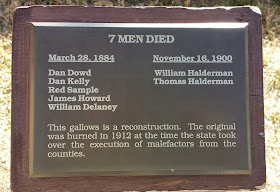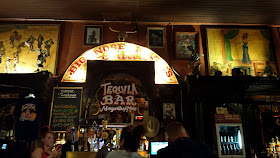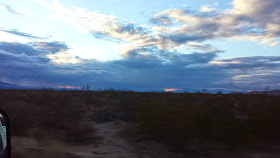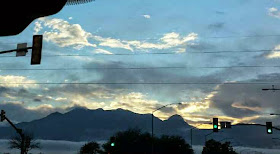January 9, 2015
Surprise the sun is out this morning it is still a little on the chilly side, 37 degrees, but we will just be happy it is not below zero or snowing.
As I mentioned in an earlier post the campgrounds we choose to stay at is called Mountain View RV Park. So I thought I would share our two mountain views. For the price we really were not expecting to much so we are pleasantly happy with what we can see out two of our windows.
The temperatures are now in the 50's and Tom decided, since there was no rule against it on the sheet of park rules, to give the Crusader a needed bath. It had gotten just a little muddy between Port Aransas and Del Rio. I do not think he could not stand it being as dirty as it was another minute...:)
Looking considerably better.
 |
Standing behind the Crusader looking at the mountains.
Site 4 |
I have taken a picture of the view from the front of the Crusader, there is a little bit of junk between us and the mountains, but I do not think I will publish it. We would rather remember this view. Though we will have the picture to remind us.
We new there was an army post nearby, Fort Huachuca, and we have heard and seen several large planes fly by so I did some checking.
****************************************
The following information and picture was taken from the internet.
Welcome to Fort Huachuca
Welcome to Fort Huachuca, home of the U.S. Army Intelligence Center and the U.S. Army Network Enterprise Technology Command (NETCOM)/9th Army Signal Command. Located in Cochise County, in southeast Arizona, about 15 miles north of the border with Mexico, Fort Huachuca was annexed in 1971 by the city of Sierra Vista and was declared a national landmark in 1976.
Fort Huachuca is also the headquarters of Army Military Affiliate Radio System (MARS) and the Joint Interoperability Test Command (JITC) and the Electronic Proving Ground (EPG).
Libby Army Airfield is located on post and shares the runway with Sierra Vista Municipal Airport; it is on the list of alternate landing locations for the space shuttle, though it has never been used as such.
History of Ft Huachuca
Fort Huachuca is a product of the Indian Wars of the 1870s and 1880s. In February 1877, Colonel August B. Kautz, commander of the Department of Arizona, ordered that a camp be established in the Huachuca Mountains. This camp would offer protection to settlers and travel routes in southeastern Arizona while simultaneously blocking the traditional Apache escape routes through the San Pedro and Santa Cruz valleys to sanctuary in Mexico. A temporary camp was established at the post’s current location on March 3, 1877, by Captain Samuel Marmaduke Whitside with two companies of the 6th Cavalry. The site was selected because it had fresh running water, an abundance of trees, excellent observation in three directions, and protective high ground for security against Apache tactical methods. Camp Huachuca was redesignated a fort in 1882.
In 1886, General Nelson A. Miles designated Fort Huachuca as his advance headquarters and forward supply base for the Geronimo campaign. Geronimo’s surrender in August 1886 practically ended the Apache danger in southern Arizona. The Army closed more than 50 camps and forts in the territory, but Fort Huachuca was retained because of continuing border troubles involving renegade Indians, Mexican bandits, and American outlaws and freebooters.
In 1913, the 10th Cavalry "Buffalo Soldiers arrived and remained almost 20 years. The 10th Cavalry joined General John J. Pershing in the 1916 expedition into Mexico and, during World War I, it was assigned the mission of guarding the United-States-Mexico border.
By 1933, the 25th Infantry Regiment had replaced the 10th Cavalry as the main combat unit for the fort. The 25th, in turn, was absorbed by the 93rd Infantry Division during World War II. When the 93rd departed for the Pacific in 1943, the 92nd Infantry Division arrived at the fort for training and subsequent assignment to the European Theater. During the war years, the troop strength reached 30,000 men at the fort, which in the 1930s had been described as suitable for a brigade-sized unit of about 10,000 men.
At war’s end, the fort was declared surplus and transferred to the State of Arizona. Itwas reactivated during the Korean War by the Army Engineers.
A new era began in 1954 when control passed to the Chief Signal Officer, who found the area and climate ideal for testing electronic and communications equipment. The importance of the fort in the national defense picture grew steadily from that moment. In 1967, Fort Huachuca became the headquarters of the U.S. Army Strategic Communications Command.
Then, in 1971, the post became the home of the U.S. Army Intelligence Center and School, bringing with it the School Brigade.
The Strategic Communications Command became the U.S. Army Communications Command in 1973, subsequently changing to the U.S. Army Information Systems Command in 1984.
In October 1990, the post changed hands with the U.S. Army Training and Doctrine Command became the new host command; the U.S. Army Intelligence Center and Fort Huachuca now operates the post.
Today, Fort Huachuca is a major military installation in Arizona, and one of prominence throughout the Southwest.
Thunder Mountain
The post sits at the base of the Huachuca Mountains. That name comes from an obscure, local Indian language which, when loosely translated, describes a "place of thunder".
Thunder Mountain is the nickname of choice among locals and it’s accurate as well, depending on the time of the year. The sight of dark clouds, cascading down the mountainside while electricity, thunderclaps, and water fill the air can be as awesome to modern man as it must have been to ancient Indians. The name must have referred to the visual spectacle rather than its frequency because, actually, Thunder Mountaineers enjoy some the of the mildest and best weather in Arizona.
The original Fort Huachuca cantonment was declared a National Historic Landmark in March 1977 during a four-day centennial celebration. A rustic wooden sign and reconstructed artillery piece sit on the northeast corner of Brown Parade Field, the center of post life during the days of horse soldiers. Surrounding buildings and homes are maintained with the appearance and flavor of the old days.
Historical Museum
When Captain Whitside led his column from the 6th Cavalry into southern Arizona and into the annals of history, he could scarcely be aware that the temporary post he was ordered to establish in the foothills of the Huachuca Mountains would survive to play a major role in the drama of the western United States.
The fascinating history of the U.S. Army in the Southwest, as well as the history of the Southwest itself, unfolds at the Fort Huachuca Historical Museum. Opened in 1960, the museum has grown rapidly and now houses one of the most representative collections in the state. The museum is one of some 500 in the country to be accredited by the American Association of Museums. Its goals have remained unchanged. Simply said, the Fort Huachuca Historical Museum endeavors to bring to the military community and general public a heightened awareness of, and an increased appreciation for, the colorful history of the Southwest and, especially, the prominent part played by the U.S. Army.
The exhibits are instructive, entertaining, and aesthetically satisfying. Some of the U.S. Army manuscripts and documents, dating back as far as 1861, can tell the viewer a great deal about the way of life on a rugged frontier.
The museum, in building 41401, is open to the public without charge. Civilian visitors are welcome. Hours are 9 a.m. to 4 p.m., Monday through Friday, and 1 p.m. to 4 p.m., Saturday and Sunday. A leisurely walk through the museum has proven to be an enriching and stimulating experience for the thousands of guests who visit each month.
A Museum Annex across the street from the Fort Huachuca Historical Museum was officially opened in 1982, adding much-needed space to display some of the artifacts belonging to the museum. The renovation and reconstruction of the building, formerly a theater, took approximately two years to complete.
****************************************
I realize this is probably more information then most would want but I found it interesting and wanted it to be part of our blog. (Thomas I am sure you enjoyed reading this.) This has been added to things it would be nice to see while we are here.
Tom thought it would be a good day to have the oil changed on the truck so he drove over to Sierra Vista to have it taken care of.
While he was gone I organized the photos we have so far and downloaded them to the computer.
I made dinner when he got back and we sat down and enjoyed our meal.
As we just sit and relax for the rest of the evening so ends this day, a day that was enjoyed.
"So often we become so focused on the finish line
that we fail to enjoy the journey."
~Dieter F. Uchtdorf





















































